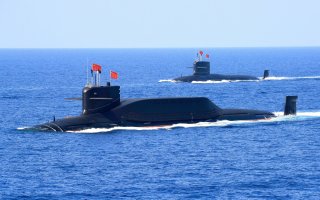Will China’s Jin-Class Submarine Rival America's Emerging Columbia-Class?
By any estimation, the Jin-class could easily hold the continental U.S. at great risk.
Here's What You Need to Know: The future of submarine warfare is upon us.
While it is likely little known about the exact technological make-up of the emerging Chinese Jin-class SSBN, it might not rival the emerging U.S. Columbia-class submarine. After all, the new, now-in-development Columbia class may be the quietest undersea boat ever to exist. It uses a quiet, efficient electric-drive and a differently configured X-shaped stern, among other technologies.
What is known about the Chinese Jin-class is that it will be armed with the extremely lethal, 5,600-mile range nuclear-armed ballistic JL-3 missiles, according to a May 2020 Congressional Research Service Report called “China Naval Modernization: Implications for U.S. Navy Capabilities.” Moreover, a 2018 CSIS report states the Chinese have already test-fired the weapon which, by any estimation, could easily hold the continental U.S. at great risk.
The Columbia class is to be equipped with an electric-drive propulsion train, as opposed to the mechanical-drive propulsion train used on other Navy submarines.
In today’s Ohio-class submarines, a reactor plant generates heat which creates steam, Navy officials explained. The steam then turns the turbines that produce the sub’s electricity and also propels the ship forward. This propulsion is achieved through “reduction gears” which are able to translate the high-speed energy from a turbine into the shaft RPMs needed to move a boat propeller.
“The electric-drive system is expected to be quieter (i.e., stealthier) than a mechanical-drive system,” a Congressional Research Service report on Columbia-Class submarines from last year states.
The submarines are designed to be 560-feet long and house sixteen Trident II D5 missiles fired from 44-foot-long missile tubes.
The “X”-shaped stern will restore maneuverability to submarines; as submarine designs progressed from using a propeller to using a propulsor to improve quieting, submarines lost some surface maneuverability, Navy officials explained.
Navy developers explain that electric-drive propulsion technology still relies on a nuclear reactor to generate heat and create steam to power turbines. However, the electricity produced is transferred to an electric motor rather than so-called reduction gears to spin the boat’s propellers.
The use of an electric motor brings other advantages as well, according to an MIT essay written years ago when the electric drive was being evaluated for submarine propulsion.
Using an electric motor optimizes the use of installed reactor power in a more efficient way compared with mechanical drives, making more on-board power available for other uses, according to an essay called “Evaluation and Comparison of Electric Propulsion Motors for Submarines.” Author Joel Harbour says that on mechanical drive submarine, 80-percent of the total reactor power is used exclusively for propulsion.
“With an electric drive submarine, the installed reactor power of the submarine is first converted into electrical power and then delivered to an electric propulsion motor. The now available electrical potential not being used for propulsion could easily be tapped into for other uses,” he writes.
Research, science and technology work and the initial missile tube construction on Columbia-Class submarines have been underway for several years. One key exercise, called tube-and-hull forging, involves building four-packs of missile tubes to assess welding and construction methods. These structures are intended to load into the boat’s modules as construction advances.
The Columbia class also incorporates a number of technologies specifically developed for the Block III Virginia-class attack submarines, such as a computer-driven joystick navigation system, fly-by-wire technology and fiber-optic periscope technology. The automated navigation enables the submarine to automatically set depth and speed, while allowing a human operator to remain in a command and control role.
Kris Osborn is the new Defense Editor for the National Interest. Osborn previously served at the Pentagon as a Highly Qualified Expert with the Office of the Assistant Secretary of the Army—Acquisition, Logistics & Technology. Osborn has also worked as an anchor and on-air military specialist at national TV networks. He has appeared as a guest military expert on Fox News, MSNBC, The Military Channel, and The History Channel. He also has a Masters Degree in Comparative Literature from Columbia University.
This article first appeared earlier this year.
Image: Reuters

